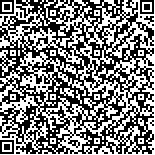| Quote
: |
叶勇,吴吉,赵凡,朱沁泉,张涤.基于网络药理学结合动物实验探究六味地黄丸治疗孤独症谱系障碍的作用机制[J].湖南中医药大学学报英文版,2024,44(2):185-196.[Click to copy
] |
|
| |
|
|
| This paper
:Browser 1866times Download 960times |
| 基于网络药理学结合动物实验探究六味地黄丸治疗孤独症谱系障碍的作用机制 |
| 叶勇,吴吉,赵凡,朱沁泉,张涤 |
| (湖南中医药大学第一中医临床学院, 湖南 长沙 410208;湖南中医药大学第一附属医院, 湖南 长沙 410007) |
| 摘要: |
| 目的 采用网络药理学、分子对接技术结合动物实验探究六味地黄丸治疗孤独症谱系障碍(autism spectrum disorder,ASD)的潜在作用机制。方法 通过TCMSP数据库获取六味地黄丸的有效活性成分及对应的靶基因信息,通过GeneCards、OMIM、DrugBank数据库获取ASD疾病靶基因;将上述靶基因用韦恩图取交集后再用STRING数据库构建关键靶点PPI网络;用Metascape数据库对关键靶点进行GO功能和KEGG信号通路富集分析;用Autodock软件对核心靶点及六味地黄丸有效成分进行分子对接。动物实验验证:选用8只SPF级SD孕鼠,随机分为空白孕鼠组(1只)及模型孕鼠组(7只),采用腹腔注射丙戊酸钠(valproate,VPA)造模。筛选符合ASD疾病模型的30只雄性仔鼠,随机分为模型对照组,维生素D组和中药高、中、低剂量组;同样筛选出空白仔鼠,为空白组,每组6只。中药低、中、高剂量组分别予六味地黄丸悬浮液0.75、1.5、3 g/kg灌胃;维生素D组予维生素D滴剂1 480 IU/kg灌胃;模型组、空白组予等量生理盐水灌胃。均干预1次/d,连续干预2周。采用三箱社交实验、旷场实验评估大鼠社交情况;ELISA检测各组仔鼠海马体糖原合成酶激酶3β(glycogen synthase kinase 3β,GSK3β)、β-连环蛋白(β-Catenin)水平;Western blot检测各组仔鼠海马体中β-Catenin、髓细胞增生原癌基因(cellular myelocytomatosis oncogene,c-Myc)、细胞周期蛋白D1(cell cycle protein D1, Cyclin D1)蛋白表达水平。结果 从六味地黄丸中筛选共得到74个活性成分及205个药物靶基因,3 903个ASD疾病靶基因,127个关键靶点及蛋白激酶B α(protein kinase B α,Akt1)、白细胞介素-6(interleukin-6,IL-6)、白细胞介素-1(interleukin-1,IL-1)、肿瘤坏死因(tumor necrosis factor,TNF)等核心靶点。GO功能富集显示主要作用于有机氮原化合物的细胞反应、突触后膜、突触后神经递质受体活动等,KEGG通路富集显示调控TNF、核因子κB(nuclear factor-κB, NF-κB)、Wnt等信号通路。分子对接结果显示,六味地黄丸中的有效成分可与核心蛋白Akt1结构稳定。动物实验结果显示,在社交能力测试阶段,模型组、维生素D组及中药低、中、高剂量组仔鼠接触陌生鼠1的时间均短于空白组(P<0.05);给药2周后,维生素D组及中药低、中、高剂量组接触陌生鼠1的时间延长(P<0.05)。在社交新颖性测试阶段,模型组、维生素D组和中药低、中、高剂量组仔鼠接触陌生鼠2的时间短于较空白组(P<0.05);给药2周后,维生素D组及中药低、中、高剂量组接触陌生鼠2的时间延长(P<0.05)。矿场实验结果提示,治疗后,中药低、中剂量组活动总路程及中央区域活动路程均增加(P<0.05),维生素D组、中药高剂量组活动总路程增加(P<0.05)。与模型组比较,维生素D组及中药低、中、高剂量组GSK-3β水平升高(P<0.05),β-Catenin水平降低(P<0.05),β-Catenin、c-Myc蛋白表达减少(P<0.05);中药低剂量组Cyclin D1蛋白表达减少(P<0.05)。结论 六味地黄丸可有效调控Wnt信号通路,改善VPA诱导的ASD仔鼠社交行为、焦虑状态。 |
| 关键词: 网络药理学 分子对接 六味地黄丸 孤独症谱系障碍 Wnt信号通路 |
| DOI:10.3969/j.issn.1674-070X.2024.02.003 |
| Received:December 04, 2023 |
| 基金项目:湖南省科技厅重点领域研发计划项目(2019SK2081);湖南省卫生健康委员会科研课题项目(202206010043);湖南省中医药科研课题(A2023036);湖南中医药大学校极研究生创新课题项目(CX20220803);卫生健康高层次人次计划项目(czxm-rsk-2023002)。 |
|
| Mechanism of action of Liuwei Dihuang Pill in treating autism spectrum disorder based on network pharmacology and animal experiments |
| YE Yong,WU Ji,ZHAO Fan,ZHU Qinquan,ZHANG Di |
| (The First Clinical School of Chinese Medicine, Hunan University of Chinese Medicine, Changsha, Hunan 410208, China;The First Hospital of Hunan University of Chinese Medicine, Changsha, Hunan 410007, China) |
| Abstract: |
| Objective To explore the potential mechanism of action of Liuwei Dihuang Pill(LWDHP) in treating autism spectrum disorder(ASD) using network pharmacology, molecular docking technology, and animal experiments.Methods The active ingredients and corresponding target gene information of LWDHP were obtained through the TCMSP database, and ASD disease target genes were obtained through the databases of GeneCards, OMIM, and DrugBank; the above target genes were intersected with Venn diagram, and then the STRING database was used to construct the PPI network of the key targets; GO and KEGG enrichment analyses of the key targets was performed using the Metascape database. The Autodock software was used for molecular docking of the core targets and active ingredients of LWDHP. Animal experimental verification:Eight SPF SD pregnant rats were randomized into blank pregnant rat group(n=1) and model pregnant rat group(n=7) which was modeled by intraperitoneal injection of sodium valproate(VPA). Thirty neonatal male rats conforming to the ASD disease model were selected and randomly subdivided into model group, vitamin D group, high-, medium-, and low-dose LWDHP groups, meanwhile, the neonatal rats from blank pregnant rat group were selected as blank group, with six rats in each group. Low-, medium-, and high-dose LWDHP groups were given 0.75, 1.5, and 3 g/kg LWDHP suspension, respectively, vitamin D group 1 480 IU/kg vitamin D drops, and model and blank groups an equal amount of normal saline, once a day by gavage, continuously intervened for two weeks. Then, three-box social test and open field test were conducted to evaluate the social behaviors of rats. ELISA was used to determine the levels of glycogen synthase kinase 3β(GSK3β) and β-catenin in the hippocampus of the neonatal rats in each group; Western blot was used to examine the protein expression levels of β-catenin, cellular myelocytomatosis oncogene(c-Myc), and cell cycle protein D1(Cyclin D1) in the hippocampus.Results A total of 74 active ingredients and 208 drug target genes of LWDHP were obtained, as well as3,903 ASD disease target genes and 127 key targets including core targets of protein kinase B α(Akt1), interleukin-6(IL-6), interleukin-1(IL-1), and tumor necrosis factor(TNF), etc.; GO function enrichment showed that LWDHP mainly acted on cellular responses of organic nitrogen-containing compounds, postsynaptic membranes, and postsynaptic neurotransmitter receptor activity, and others; KEGG pathway enrichment showed that it regulated signaling pathways of TNF, nuclear transcription factor-κB(NF-κB), Wnt, and others;the molecular docking showed that the active ingredients in LWDHP could be structurally stable with the core protein Akt1.Animal experiments showed that in the test of social ability, compared with blank group, the neonatal rats in model group, vitamin D group, and low-, medium-, and high-dose LWDHP groups had shorter contact time with unfamiliar rat Ⅰ(P<0.05); after 2 weeks of administration, the contact time with unfamiliar rat Ⅰ of the neonatal rats in vitamin D group and low-, medium-, and highdose LWDHP groups was prolonged(P<0.05). In the test of social novelty, the neonatal rats in model group, vitamin D group, and low-, medium-, and high-dose LWDHP groups had shorter contact time with unfamiliar rat Ⅱ compared with those in blank group(P<0.05); after 2 weeks of administration, the contact time with unfamiliar rat Ⅱ of the neonatal rats in vitamin D group and low-,medium-, and high-dose LWDHP groups was prolonged(P<0.05). The open field test showed that after treatment, both the total activity distance and activity distance in the central area of the neonatal rats in low-and medium-dose LWDHP groups increased(P <0.05), and the total activity distance of the neonatal rats in vitamin D and high-dose LWDHP groups increased(P <0.05).Compared with model group, vitamin D group and low-, medium-, and high-dose LWDHP groups showed higher GSK-3β level(P<0.05), lower β-Catenin level(P<0.05), and reduced protein expressions of β-Catenin and c-Myc(P<0.05); the protein expression of Cyclin D1 in low-dose LWDHP group decreased(P<0.05).Conclusion LWDHP can effectively regulate the Wnt signaling pathway,and improve the social behaviors and reduce anxiety of rats with VPA-induced ASD. |
| Key words: network pharmacology molecular docking Liuwei Dihuang Pill autism spectrum disorder Wnt signaling pathway |
|

二维码(扫一下试试看!) |
|
|
|
|


